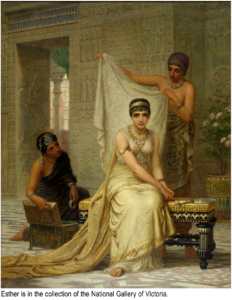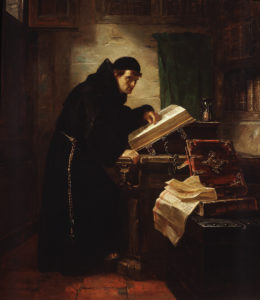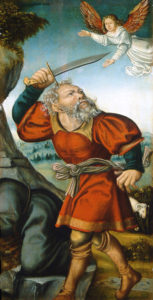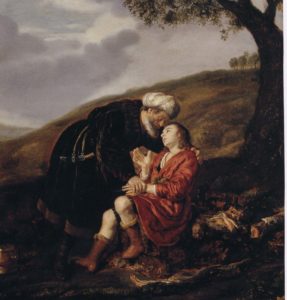Salome with the Head of St. John the Baptist
Lucas Cranach the Elder
Below the image, click play to listen.
Oil on canvas
English, 1829-1891

Vashti showcases Edwin Long’s interest in archeological discovery, religious history, and female beauty on a grand scale, interests that reflect those of the Victorian era in which he lived. And the story of the two queens of Xerxes, king of Persia, is tailor made for both his interests and his skills. Like other religious painters of the era, such as William Holman Hunt, Long actually visited the Holy Land to gain firsthand knowledge. He combined this trip with various print sources such as volume III of George Rawlinson’s The Five Great Monarchies of the Ancient Eastern World (1862-67) and Austen Henry Layard’s studies from Nineveh in order to create this painting of convincing Orientalism. Originally exhibited at Burlington House in 1879 with its companion piece, Queen Esther, the two paintings taken together (though not exhibited side by side) offer food for thought both on the characters of these impressive women and the critical period in which they lived.
Vashti opens the story of Esther with a dramatic refusal to appear at her husband’s banquet for the rulers of the Persian kingdom. Whether she refuses out of modesty (her crossed arms seem to support this position) or because she herself is hosting a banquet for the wives of the rulers, her refusal is seen as a harbinger of marital unrest in the kingdom if her disobedience goes unanswered. So the king is persuaded to depose her as queen and seek a new one. There are several indications that Vashti recognizes the serious implications of her rebellion. She is remonstrated by her maidens, there is an apparent altercation at the door between those delivering her refusal and those demanding her acquiescence, and her body language suggests that she is afraid of what is to come.
The symbolism so greatly loved by the Victorians comes into play through the great lion on which she sits. An emblem associated by the Persians with their great power, the lion reflects both the power that has made her queen and the power which she will be unable to thwart. Though the lion is itself slain and has lost its power over her, even serving as a bench cushion; one lone woman cannot stand against an Eastern potentate. Her name which means “Beautiful One” in Persian appropriately reflects her physical beauty, likely the avenue to her queenly position. However, beauty is hardly a weapon against the mighty Persians. Or is it?
 Consider the story of Hadassah or Esther as most know her today. An entire book of the Bible, one in which there is no direct mention of Jehovah, chronicles a few brief years of a young Jewish maiden who had “come to the kingdom” (Esther 4:14) at a crucial time, not just as a result of the whim of the queen. Long means for viewers to examine these women in light of each other. A cursory glance reveals that the two paintings are meant as companions: the matching frames, the seated central figures, the inquisitive gaze and pose of the servant girl, the visible sandaled foot of both women. Even the “X” created by the arms of Vashti and the jewelry of Esther juxtapose these two women and their plights: one is apparently guarding her beauty from the ravaging eyes of the rulers, the other finds her beautiful figure emphasized in the king’s competition.
Consider the story of Hadassah or Esther as most know her today. An entire book of the Bible, one in which there is no direct mention of Jehovah, chronicles a few brief years of a young Jewish maiden who had “come to the kingdom” (Esther 4:14) at a crucial time, not just as a result of the whim of the queen. Long means for viewers to examine these women in light of each other. A cursory glance reveals that the two paintings are meant as companions: the matching frames, the seated central figures, the inquisitive gaze and pose of the servant girl, the visible sandaled foot of both women. Even the “X” created by the arms of Vashti and the jewelry of Esther juxtapose these two women and their plights: one is apparently guarding her beauty from the ravaging eyes of the rulers, the other finds her beautiful figure emphasized in the king’s competition.
Both women are “caught” by their positions though their gazes differ: Vashti’s gaze foreshadows her fall from favor while the frank gaze of the powerless girl (even her beauty is no match for an unextended scepter) foreshadows her strength of spirit. The adorned Esther has put down the mirror, rejecting the offer of more jewels. Instead, just prior to being veiled and taken to Xerxes, she looks directly at the viewer. This gaze, though solemn, reveals no fear in the innocent young girl (notice the lilies on the wall relief behind her) who by the next day will be either a mere concubine or the queen. The mythical griffins embroidered on the hem of her gown were figures used to guard the gold of the Persians and are another indication both of the marketplace contest she is part of and her inability to escape. Yet Esther has an inner strength that enables her to risk death at the hands of the king—in order to invite him to dinner!
Though Vashti is gone by the end of the first chapter of Esther, she begins the rising action of the story whose crisis is faced by her youthful successor. Without the brave action of Vashti, Esther would not have been in place to rescue her people. And without the brave action—and clever thinking—of Queen Esther, the Israelites would have lost their stand against the “divine” power (note the stylized sun on the end of the mirror handle and on Vashti’s belt) of the pagan Persians at the hands of Haman. If “the king’s heart is in the hand of the Lord” (Proverbs 21:1), it is certain the hearts of queens are as well. Edwin Long’s works draw attention to both the historical tensions in the Persian royal court and the metanarrative of the Israelites’ position as God’s chosen people.
Dr. Karen Rowe, M&G Board Member
Published in 2019
Oil on canvas, Signed and dated, Félix Leullier, 1880
French, 1811–1882
In this arresting example of the nineteenth-century Romantic style, Felix Louis Leullier uses all the forces of paint and position to create a gruesome depiction of one of the most famous martyrdoms of the Christian church. Little known outside of France, Felix trained with Antoine-Jean Gros, renowned for his depictions of some of Napoleon’s famous battles: Battle of Arcole, Napoléon on the Battlefield of Eylau, and Battle of Abukir. Gros leaves little to the imagination in the spheres of conflict and conquest, so it is no wonder that his student, Felix, would choose to depict a martyrdom in a context resembling the twisted forms often found on a battlefield.
The painting’s setting is the Roman Amphitheatre in Carthage, the North African center of Christianity in the early centuries following Christ’s death and resurrection; there is little more than an outline remaining today of the prominent structure that seated 30,000. Although Felix most likely did not travel to that part of the world, he could have easily participated in a Grand Tour, a customary excursion in the 18th and 19th centuries for men coming of age, to see and learn from the culture and histories of antiquity. Such a broadening and experiential trip included significant time in Rome, where the Colosseum was a chief point of interest and which is very similar to Carthage’s own great amphitheater. The combined influence of travel and exposure to prominent depictions like Granet’s Interior View of the Colosseum in Rome, 1804 and Towne’s The Colosseum, 1781, Leullier opts to create only a faint representation of an outdoor arena.
On March 7, 203 AD, under the rule of the Roman emperor, Septimius Severus, the noblewoman Vibia Perpetua, was executed with her handmaid, Felicitas, and fellow catechumens, Revocatus, Saturninus, and Secundulus. Just a few years earlier in 197 AD in his treatise Apologeticus, Tertullian had posited that “the blood of the martyrs is the seed of the church.” As providence would have it, Tertullian himself was eyewitness and later chronicler to the gripping event portrayed in this work.
In addition to Tertullian’s account and Perpetua’s own prison diary, Passio Perpetuae et Felicitatis, in which she captures much of the detail up until the hour of her entrance into the arena, many attempts to present the event have been created in various media formats. It is contained in older volumes like Foxe’s Book of Martyrs (1563), as well as in more recent accounts like Thomas J. Heffernan’s The Passion of Perpetua and Felicity (2012). It is visible in paintings, drawings, mosaics, stained glass and illuminated manuscripts like Menologion of Basil II; and it has been presented in investigative journalism in the PBS Frontline series, From Jesus to Christ (1998).
Leullier’s visual rendering is indeed grand both in presentation and size, measuring nearly seven feet high by nine feet wide. Though literary works relate that Perpetua and Felicitas were martyred separately from the men, Leullier deviates from the historical account and instead depicts the entire company—the martyrs, the men that assaulted them, and the many animals that mauled them. By placing the massacre in the forefront of the work, the purity and testimony of these Christians’ story cannot be ignored.
Bonnie Merkle, M&G Database Manager and Docent
Published in 2018
Oil on canvas, Initialed and dated, lower right: JB 1652
Flemish, c. 1604–1668
Click on the link for additional reference information.
Among the Museum & Gallery’s collection, there are both famous and unknown artists. But what about those who fall right in the middle? What about the artists who have active careers and equal skill to the “greats,” but never achieve the fame of their contemporaries? One of these artists is the Flemish master, Jan Boeckhorst.
Jan Boeckhorst, nicknamed Lange Jan (“Tall John”) was born in Münster, Germany in 1604. At seventeen, he became a canon in the Jesuit church, but at the advanced age of twenty-two (long past the standard age for training) decided to become a painter.
In the 1620s, he moved to the coastal city of Antwerp—home to some of the greatest artists of his time. Some historians claim he studied with Jacob Jordaens while others say it was Peter Paul Rubens. More than likely, Boeckhorst studied with Jordaens because Rubens was in Spain and England in the late 1620s. Around 1634, Boeckhorst achieved the title of Master in Antwerp’s Guild of St. Luke and worked alongside the other Flemish masters including Rubens and Anthony van Dyck. Boeckhorst visited Italy twice to study the sixteenth-century Venetian masters such as Titian and Tintoretto and returned to Antwerp by 1640.
Throughout his later life, he painted a variety of subject matter including religious and mythological for church altarpieces and private collectors. His artistic work ranged from paintings, designing tapestries, and illustrating for religious books. He also contributed to the founding of the Antwerp Academy. After a full life, he died on April 21, 1668.
Despite his active career, much of Boeckhorst’s work is unknown, unsigned or wrongly attributed, so it has been difficult to compile a comprehensive list of his art. One of the reasons his work might be misattributed is his close work relationship with Rubens. There are many evidences of their collaboration based on the standard studio practice of the time. Boeckhorst would help touch up paintings under Rubens’ instructions and even assisted the master in large commissions. After Rubens’ death in 1640, Boeckhorst finished or even restored Rubens’ remaining works. An example of their collaboration is King David Playing the Harp at the Städel Museum.
In M&G’s collection, there are three paintings by Boeckhorst; of these The Adoration of the Magi is considered his greatest work in America. In the lower right corner, his initials and date are painted on a rock face: JB 1652.
Boeckhorst displays a heightened attention to texture with the wafting incense, richness of the garments, and different animals. Because of his saturated colors, graceful composition and dramatic movement, scholars consider this painting to be a masterpiece of the High Baroque style.
KC Christmas, M&G graduate assistant
Published in 2017
Oil on canvas, Signed and dated: E. Crowe, 1864 (lower left)
English, 1824–1910
Click on links for additional reference information.
Martin Luther truly changed the course of history, but it was English painter Eyre Crowe who captured the defining moment. Wittenberg, October 31, 1517, has long been a favorite of M&G guests for its historical accuracy. “Story paintings,” a common name for the genre of this piece, invite investigation, and recent research on Crowe’s work has revealed that there is “more of the story to tell.”
The obvious historical event being pictured here is Luther’s nailing of the 95 Theses to the door of the University of Wittenberg Chapel. But it may very well be that Crowe purposely wove together additional personages and objects which served to emphasize the crux of the matter which prompted Luther’s action – plenary indulgences offered by the Roman Catholic church.
The prominent horseman on the left, Johann Tetzel, holds in his left hand a grid-like object with dangling metal bulla. The embedded papers, inscribed with numbers representing days or years in purgatory that could be lessened, were purchased by anxious parishioners seeking to relieve themselves or their dead of suffering. Coins clunking in the coffer Tetzel holds evokes the rhyme that still rings through the halls of history.
Worshippers could also acquire relief from anguish by employing a prayer to Mary, Christ’s mother, called The Rosary. In order to count the component invocations, or “tell the beads,” individuals held an object known as a rosary. Rosaries took on many forms (chaplets, ropes, decade and pomander rings) of varying materials (wood, glass, seeds and plastic). Crowe identifies medieval rosary rings reminiscent of a carnival ring toss game by placing examples in the foreground. He continues to add additional weight to his emphasis by sprinkling rosary types, either held or worn, near the significant people in Luther’s life. Research required to accomplish such a historically accurate piece likely led Crowe to such paintings as The Arnolfini Wedding by Jan van Eyck and The Feast of the Rosary by Albrecht Dürer both of which contain prayer beads.
Prominently represented left center and wearing regal garb is Margaret of Münsterberg with her son George III clinging to her skirt. Bereft of her husband, Prince Ernest I of Anhalt-Dessau, and left with three sons too young to assume regency, Margaret undertook her new position as princess regent with vigor and religiosity. Strongly adverse to the Reformation, she organized the League of Dessau. Though unsuccessful in thwarting the spread of the Reformers’ teaching, it is very possible the League exposed her sons to Luther and his doctrine. Letters were exchanged between Luther, Margaret, and her offspring, which resulted in her sons’ adopting the tenets of Lutheranism in their adult years. George ultimately was ordained by Luther, making him the only German prince to be inducted into the Lutheran clergy.
As if to make a final point on the issue of indulgences, the artist places in each of Margaret’s hands a rosary – one a ring and the other a wooden beaded arrangement. A woman of means who could certainly afford some of the extravagant materials used for rosaries of the period, Margaret, however, emulates her sovereign ruler, Charles V, by clutching a poor man’s wooden one.
In Eithne Wilkins’ The Rose Garden Game; the Symbolic Background to the European Prayer Beads, the author details the varying philosophies associated with a worshipper’s choice of rosary materials:
Beauty of material and elaborate workmanship over against ascetic simplicity remains an issue, as might be expected throughout the centuries. The principle of making the external object conform with the interior purpose can be interpreted in two ways. One may feel, as Lady Godiva did in the eleventh century, that it is fitting to count one’s prayers on jewels, for they are being offered to God. Or one may feel that a wretched sinner like oneself should not presume to offer prayers on any but the plainest beads. This sort of self-abasement may even be more effective than any flashing of gems. That was so when in 1532 and again in 1541 the Emperor Charles V, taking part in the Corpus Christi procession at Regensburg, carried ‘ordinary little brown wooden beads’: it was, the commentator pointed out, ‘to mark his humility.’ The ostentation of some people’s display evoked criticism as early as 1261, and fashion was not always on the side of luxury: Emperor Charles V carried ordinary little brown wooden beads…to mark his humility.
Crowe has also included the historical likenesses of other key people from sixteenth-century Wittenberg on the right side of the painting. Katherina von Bora, the nun who eventually married Luther, is present with Luther’s father, mother, and sister. To the left of Katherina von Bora is Luther’s artist friend, Lucas Cranach, the Elder.
Wittenberg, October 31, 1517 is exhibited as part of Luther’s Journey: Experience the History on view in the Gustafson Fine Art Center on the campus of Bob Jones University. Information about the exhibit and the accompanying tour is available here: www.museumandgallery.org/specialized-tours/
Bonnie Merkle, Internal Database Manager and Docent
Published in 2017
Oil on canvas, Signed and dated: E M Ward, R A, 1868 (lower left)
English, 1816–1879

Edward Ward’s portrait of Martin Luther Discovering Justification by Faith draws on traditional elements of portraiture. Like most scholar portraits, this one places the sitter in his “study” surrounded by precious manuscripts and books on theology.
An enormous Bible is chained to the lectern. Bibles were rare and expensive to construct during the sixteenth century and were usually chained so that they would not be moved or lost. But here the chain is also symbolic. In the context of the reformer’s inner turmoil, the chain represents the inaccessibility of God’s Word—an obstacle that Luther is about to overcome through his discovery. This moment of enlightenment is also foreshadowed by the light streaming in through the open window, a common motif symbolizing heavenly illumination.
In addition, the hourglass as a symbol of time represents not only the brevity of this life (through the falling sand) but also the possibility of resurrection (through reversing the glass).
Like Ward’s beautifully rendered portrait, the following fragment from Luther’s autobiography vividly captures the power of this moment:
Night and day I pondered until I saw the connection between the justice of God and the statement ‘the just shall live by his faith.’ Then I grasped that the justice of God is that righteousness by which, through grace and sheer mercy, God justifies us through faith. Thereupon I felt myself to be reborn and to have gone through open doors into paradise. The whole of Scripture took on new meaning, and whereas before ‘the justice of God’ had filled me with hate, now it became to me inexpressibly sweet in greater love. This passage of Paul became to me the gate of heaven.
Click on the dropdown information below for further insights:
Although opposed to the veneration of images, Martin Luther did not object to using art in worship or in education. According to Luther, images “are neither good nor bad.” They are “unnecessary and we are free to have them or not.” He went on to say that visual art may be of considerable benefit in preaching and teaching the good news (as his artist friends the Cranachs sought to do). However, the leading Swiss reformer Huldrych Zwingli disagreed vehemently with Luther on this issue. Zwingli who preached for twelve years at the famed Grossmünster’s pulpit in Zurich ordered all altar paintings and statues removed from the church. This church, which still stands today, remains “quite bare, entirely stripped of the statues and paintings denounced by Zwingli.”
As the years passed the debate on the use of images in worship and religious education became less strident, though differences remained. For example, unlike Luther’s followers, artists like Jan Victors who embraced Calvin’s ideas refused to paint images of God (including God the Son), opting to focus on Old Testament scenes or New Testament parables.
Abraham’s sacrifice of Isaac was one subject that captured the imagination of those on both sides of the debate. This Old Testament narrative adumbrating Christ’s atoning grace was central to all Protestant theologians, but the prophetic vehicle allowed artists who held views similar to Zwingli or Calvin to avoid violating their conscience in visually rendering God the Son.
The Sacrifice of Isaac by Lucas Cranach, the Elder, a friend and follower of Luther captures the climactic moment of the story.
The reproduction below is by one of Calvin’s followers, Jan Victors. Victor’s rendering of the biblical narrative captures the intimate moment between father and son just before Isaac is bound the altar.


Donnalynn Hess, Director of Education
Published in 2017